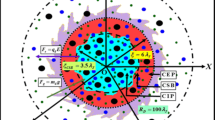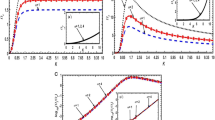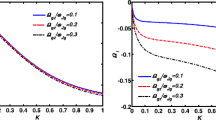Abstract
A classical formalism for the weakly nonlinear instability analysis of a gravitating rotating viscoelastic gaseous cloud in the presence of gyratory dark matter is presented on the cosmic Jeans flat scales of space and time. The constituent neutral gaseous fluid (NGF) and dark matter fluid (DMF) are inter-coupled frictionally via mutual gravity alone. Application of standard nonlinear perturbation techniques over the complex gyro-gravitating clouds results in a unique conjugated pair of viscoelastic forced Burgers (VFB) equations. The VFB pair is conjointly twinned by correlational viscoelastic effects. There is no regular damping term here, unlike, in the conventional Burgers equation for the luminous (bright) matter solely. Instead, an interesting linear self-consistent derivative force-term naturalistically appears. A numerical illustrative platform is provided to reveal the micro-physical insights behind the weakly non-linear natural diffusive eigen-modes. It is fantastically seen that the perturbed NGF evolves as extended compressive solitons and compressive shock-like structures. In contrast, the perturbed DMF grows as rarefactive extended solitons and hybrid shocks. The latter is micro-physically composed of rarefactive solitons and compressive shocks. The consistency and reliability of the results are validated in the panoptic light of the existing reports based on the preeminent nonlinear advection-diffusion-based Burgers fabric. At the last, we highlight the main implications and non-trivial futuristic applications of the explored findings.








Similar content being viewed by others
References
Ablowitz, M.J.: Nonlinear Dispersive Waves—Asymptotic Analysis and Solitons. Cambridge University Press, Cambridge (2011)
Beringer, J., et al. (Particle Data Group): Phys. Rev. D 86, 010001 (2012)
Bertin, G.: Dynamics of Galaxies. Cambridge University Press, Cambridge (2014)
Binney, J., Tremaine, S.: Galactic Dynamics. Princeton University Press, Princeton (1987)
Blain, J.V.: Trends in Dark Matter Research. Nova, New York (2005)
Borah, B., Haloi, A., Karmakar, P.K.: Astrophys. Space Sci. 361, 165 (2016)
Brevik, I.: Mod. Phys. Lett. A 31, 1650050 (2016)
Burgers, J.M.: The Nonlinear Diffusion Equation—Asymptotic Solutions and Statistical Problems. Springer, Dordrecht (1974)
Frenkel, J.: Kinetic Theory of Liquids. Clarendon, Oxford (1946)
Gnedin, N.Y., Glover, S.C.O., Klessen, R.S., Springel, V.: Star Formation in Galaxy Evolution: Connecting Numerical Models to Reality. Springer, Berlin (2016)
Gurbatov, S., Saichev, A., Shandarin, S.: The large scale structure of the universe, the Burgers equation and cellular structures. In: Gaponov-Grekhov, A.V., Rabinovich, M.I., Engelbrecht, J. (eds.) Nonlinear Waves 3: Physics and Astrophysics. Springer, Berlin (1990)
Jeans, J.H.: Philos. Trans. R. Soc. A 199, 1 (1902)
Karmakar, P.K., Borah, B.: Astrophys. Space Sci. 361, 115 (2016)
Karmakar, P.K., Das, P.: Astrophys. Space Sci. 362, 115 (2017)
Landau, L.D., Lifshitz, E.M.: Fluid Mechanics. Pergamon Press, Elmsford (1987)
Lindfield, G.R., Penny, J.E.T.: Numerical Methods Using Matlab. Academic Press, San Diego (2012)
Mo, H., Bosch, F.V.D., White, S.: Galaxy Formation and Evolution. Cambridge University Press, Cambridge (2010)
Papantonopoulos, L.: The Invisible Universe: Dark Matter and Dark Energy. Lect. Notes Phys., vol. 720. Springer, Berlin (2007)
Rozelot, J.-P., Neiner, C. (eds.): The Rotation of Sun and Stars. Lect. Notes Phys., vol. 765. Springer, Berlin (2009)
Stahler, S.W., Palla, F.: The Formation of Stars. Wiley, Weinheim (2004)
Tsiklauri, D.: Astrophys. J. 507, 226 (1998)
Tsiklauri, D.: New Astron. 5, 361 (2000)
Wazwaz, A.-M.: Partial Differential Equations and Solitary Wave Theory. Springer, Berlin (2009)
Whitham, G.B.: Linear and Nonlinear Waves. Wiley, New York (1999)
Zhang, T.X., Li, X.Q.: Astron. Astrophys. 294, 334 (1995)
Acknowledgements
The valuable comments, helpful remarks and insightful suggestions received from the learned referees are duly acknowledged. The financial support from the Department of Science and Technology (DST) of New Delhi, Government of India, extended to the authors through the SERB Fast Track Project (Grant No. SR/FTP/PS-021/2011) is thankfully recognized.
Author information
Authors and Affiliations
Corresponding author
Appendix: Stationary conjugate pair VFB equations
Appendix: Stationary conjugate pair VFB equations
In order to explore the steady-state solutions for the gravitational fluctuations, Eqs. (46)–(47) are to be transformed into the corresponding time-stationary form as a first step. We introduce a standard Galilean reference frame transformation defined as, \(r: = f ( X,T ) = X - M_{f} T\), where \(M_{f}\) is the reference frame velocity (normalized by \(c_{sg}\)). It renders a liner operator transformation as \(\partial / \partial X \equiv \partial / \partial r\) and \(\partial / \partial T \equiv - \partial / \partial r\). As a consequence of this exercise, the pair VFB equations (Eqs. (46)–(47)) acquire the respective steady pair form as
and
Again, for a detailed numerical characterization of the fluctuations with computational compatibility, one-step spatial differentiation of Eqs. (49)–(50) yields
and
It is now clear that the spatiotemporal dynamics of the composite cloud fluctuations is governed by the conjugate VFB equation pair (Eqs. (46)–(47)); whereas, their spatial evolution is dictated by the conjugate derivative VFB pair (Eqs. (51)–(52)). The conjugate VFB system, which is derived under the condition of non-vanishing potential fluctuations, is numerically analyzed to portray the exact fluctuation patterns in a judicious cosmological multi-parametric platform in both the dynamic and static frames of reference as presented in the main text.
Rights and permissions
About this article
Cite this article
Karmakar, P.K., Das, P. Instability analysis of cosmic viscoelastic gyro-gravitating clouds in the presence of dark matter. Astrophys Space Sci 362, 142 (2017). https://doi.org/10.1007/s10509-017-3125-9
Received:
Accepted:
Published:
DOI: https://doi.org/10.1007/s10509-017-3125-9




